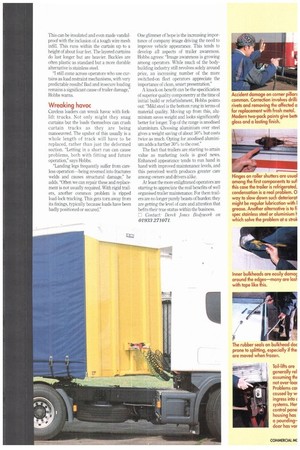trailin g
Page 46

Page 47

If you've noticed an error in this article please click here to report it so we can fix it.
1E1E11 NI,
Poor servicing, maintenance and repair of trailers could be costing you thousands of pounds in unnecessary downtime and unscheduled failures. Chris Graham looks at some of the more common problems...
Why do trailers continue to _)(' neglected? In today's harsh economic climate the temptation to cut maintenance, repair and servicing costs to the bone and lavish the lion's share of the budget on the front end of the tractor/trailer combination can be a strong one. But it is a temptation which the wise operator will resist.
Drivers and loaders should play their part too. Careless coupling, slapdash stacking and oblivious operation are all potential causes of costly problems. Trailers are widely regarded as the "poor relation" and are treated accordingly by most operators.
Kurt Hobbs, operations director at Wellingborough-based Derek Jones Bodywork, is well aware of the problems and sees the results of this treatment daily The company is mainly a bodybuilder but takes on trailer refurbishment, so the levels of neglect are often obvious.
Ilobbs explains: "Cash is thrown at tractors but trailers are usually left to fend for themselves. I can't honestly say this tendency is any less common now than it was when I entered the business 17 years ago."
This a depressing state of affairs and essentially unnecessary. Many in the road haulage industry glibly rant on about false economies, but cutting financial corners on trailer upkeep is a real and potentially dangerous one.
Hobbs says: "The most common forms of damage we see are sideguard distortion, broken or missing wings, torn spray suppression flaps and, on rigids, panel damage caused by unsecured loads. Internal bulkheads take a pounding too. These types of defect can all be expensive to put right, not necessarily because of the parts involved
but due
to the labour cost. Curtainsiders suffer too, with torn sheeting and broken buckles. Operators will often tackle this sort of running repair themselves—with varying degrees of success. Repairing torn curtains is an option, with replacement sets costing anything up to £1,000, including fitting. A professional repair costs about 200."
Curtains are also susceptible to vandalism as well as loose cargoes. Stanley knifeequipped snoopers can do plenty of damage, and while this is often beyond the operator's immediate control, precautions can be taken.
Hobbs explains: "Curtain material varies in grade. The industry standard is a two by-two weave PVC. This can be insulated and even made vandalproof with the inclusion of a tough wire mesh infill. This runs within the curtain up to a height of about four feet. The layered curtains do last longer but are heavier. Buckles are often plastic as standard but a more durable alternative is stainless steel.
"I still come across operators who use curtains as load restraint mechanisms, with very predictable results! Bad and insecure loading remains a significant cause of trailer damage." Hobbs warns.
Wreaking havoc
Careless loaders can wreak havoc with forklift trucks. Not only might they snag curtains but the loads themselves can crush curtain tracks as they are being manoeuvred. The upshot of this usually is a whole length of track will have to be replaced, rather than just the deformed section. "Letting in a short run can cause problems, both with fitting and future operation," says Hobbs.
"Landing legs frequently suffer from careless operation—being reversed into fractures welds and causes structural damage," he adds. "Often we can repair these and replacement is not usually required. With rigid trailers, another common problem is ripped load-lock tracking. This gets torn away from its fixings, typically because loads have been badly positioned or secured." One glimmer of hope is the increasing importance of company image driving the need to improve vehicle appearance. This tends to develop all aspects of trailer awareness. Hobbs agrees: "Image awareness is growing among operators. While much of the bodybuilding industry still revolves solely around price, an increasing number of the more switched-on fleet operators appreciate the importance of clean, smart presentation."
A knock-on benefit can be the specification of superior quality componentry at the time of initial build or refurbishment, Hobbs points out: "Mild steel is the bottom rung in terms of material quality. Moving up from this, aluminium saves weight and looks significantly better for longer. Top of the range is anodised aluminium. Choosing aluminium over steel gives a weight saving of about 50% but costs twice as much. Opting for anodised aluminium adds a further 30% to the cost."
The fact that trailers are starting to attain value as marketing tools is good news. Enhanced appearance tends to run hand in hand with improved maintenance levels, and this perceived worth produces greater care among owners and drivers alike.
At least the more enlightened operators are starting to appreciate the real benefits of well organised trailer maintenance. For them trailers are no longer purely beasts of burden: they are getting the level of care and attention that befits their true status within the business.
17.1 Contact: Derek Jones Bodywork on 01933 271071. Accident damage on corner pillars common. Correction involves drillil rivets and removing the affected a for replacement with fresh metal Modern two-pack paints give betti gloss and a lasting finish.
Hinges on roller shutters are usual among the first components to suf this case the trailer is refrigerated, condensation is a real problem. 0 way to slow down such deteriorat might be regular lubrication with I grease. Another alternative is to fi spec stainless steel or aluminium f which solve the problem at a strol Inner bulkheads are easily damac around the edges—many are las[ with tope like this.
The rubber seals on bulkhead doc prone to splitting, especially if the are moved when frozen.
Tail-lifts are generally rel assuming tilt not over-looi Problems cal caused by w ingress into c systems. Her control panel housing has a pounding– door has var




















































































































